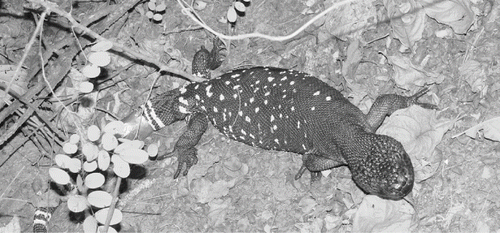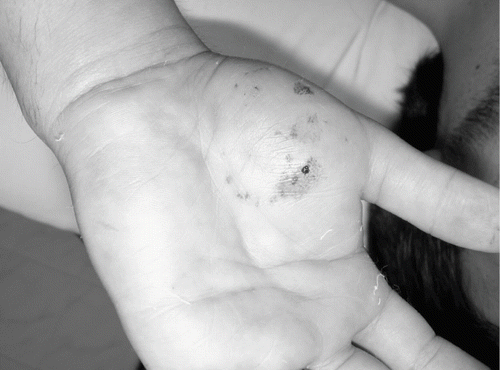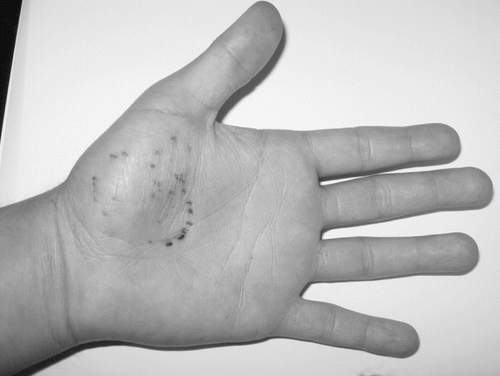Abstract
Background. The Guatemalan Beaded Lizard (Heloderma horridum charlesbogerti) is an endemic venomous lizard that inhabits southeastern Guatemala. Published reports of bites by Beaded Lizard are scarce. This is the first case report of a bite from Heloderma horridum charlesbogerti. Case report. A 24-year-old man was bitten on the left hand by a juvenile Heloderma horridum charlesbogerti. The lizard remained attached for approximately 15 seconds. The patient experienced severe local pain, dizziness, diaphoresis, vomiting, severe paresthesia in his left hand and arm, and hypotension (70/52 mm/Hg). He was treated with intravenous ketorolac, chlorpheniramine, methylprednisolone, antibiotics, ondansentron, and normal saline. Hematology tests revealed leukocytosis (12,600/mm3). Symptoms improved and the patient was discharged from hospital 24 hours after admission. Conclusion. The case reported here shows that bites by Heloderma produce severe clinical effects shortly after the bite. Management consists of waiting for the lizard to relax its bite pressure and using pliers to open lizard's mouth and pull out the bitten extremity, a careful manual search for teeth remnants, and supportive care. In our case, severe pain, unresponsive to non-steroidal anti-inflammatory analgesics, was a major problem. Parethesias resolve quickly but pain may persist for up to 12 hours after the bite. A full recovery is expected.
Introduction
The Guatemalan Beaded Lizard, Heloderma horridum charlesbogerti () is an endemic subspecies with a restricted distribution in the forest remnants of the semiarid portions of the Motagua Valley in southeastern Guatemala (Citation1,Citation2). It belongs to the Helodermatidae (Gila monsters Heloderma suspectum and Beaded Lizards Heloderma horridum spp.), which forms part of a group of lizards with toxin secreting glands (Citation3). The Guatemalan Beaded Lizard is the rarest and most endangered of the extant populations of Heloderma horridum and differs from others in coloration and size, being the smaller of the subspecies of Heloderma horridum (Citation2,Citation4).
Venom glands of helodermatid lizards are located in the mandible and its venom is released within the saliva (Citation4). Case reports of Beaded Lizard (Heloderma horridum) bites in the literature are scarce (Citation4–6); this is the first case report of a wild Guatemalan Beaded Lizard bite.
Case report
A 24-year-old man involved in field research of this species was bitten on the palm of his left hand () by a juvenile H. h. charlesbogerti, with a snout-vent length (SVL) of 285 mm, a total length of 470 mm, and a head diameter (at the part of the mandible junction) of 115 mm. The bite occurred when the researcher was handling the lizard to attach a radiotelemetry transmitter to its tail. The lizard's jaws remained attached to the patient's hand for approximately 15 seconds. The lizard was disengaged by waiting for the lizard to make a forward movement to bite more deeply in the hand. When the lizard relaxed its bite strength, the jaws were forced to open with pliers and the patient pulled his hand from the lizard's mouth. The lizard was then restrained and put in a transportation cage. The lizard was not harmed; the transmitter was put in a few days later and the lizard was released in the wild for telemetry monitoring.
After disengaging the lizard, the patient experienced severe local pain, dizziness and diaphoresis. Approximately one minute later the patient experienced paresthesia in his left hand and arm, and it became difficult to move the fingers of the bitten hand. Around 3 minutes later, it became difficult for the patient to move the fingers of the right hand, and he experienced paralysis of the left hand. There was considerable edema of the left hand, and pain extended from the tip of fingers to the shoulder. Swelling of the mid-left tongue made speech difficult. At this time the patient experienced shortness of breath and was transported to a hospital.
The patient arrived to the hospital approximately 15 minutes after the bite, at which time he was vomiting and the swelling had extended to the anterior part of the arm. The patient was calm at the time he arrived at the hospital, but had severe vomiting. His mental status was normal. The patient presented with hypotension (70/52 mm/Hg) at the time of arrival to hospital resulting in dizziness and shortness of breath. There was considerable swelling of the forearm and hand. The wound site was edematous and two pieces of teeth were found in the flesh on careful examination. The patient's heart rate was 102 beats/minute with irregular PVCs. Pulse oximetry was 99%.
Hematology tests revealed leukocytosis (12,600/mm3) not associated with a left shift. Coagulation times and urine tests were normal. An X-ray of the left hand revealed only marked soft tissue swelling. Further careful manual examination found three additional pieces of Guatemalan Beaded Lizard teeth within the flesh.
The patient was treated initially with intravenous ketorolac tromethamine 180mg, chlorpheniramine maleate 30mg, methylprednisolone sodium succinate 500mg, ampicillin sodium/sulbactam sodium combination 6000mg, ondansentron 12 mg and 1 L of normal saline. Additional doses of ketorolac tromethamine were given to the patient for control of severe pain. Opioids were not used because Guatemalan law restricts their use to terminal cases. The heart rate decreased half an hour after arrival to hospital and reached 80 beats/minute two hours after the bite. The patients arm was maintained in vertical position using pillows to help the edema to resolve. Tetanus immunization was updated.
The patient had a good response to treatment. He showed a good recovery from vomiting, hypotension, tachycardia, and dyspnea by 3 hours of his arrival to hospital. The only symptom present after that time was intense pain that remained for around 12 hours in spite of the administration of non-steroidal anti-inflammatory analgesics. The patient's symptoms improved over the next 12 hours and he was discharged from hospital after 24 hours. Two weeks after the bite, the patient had completely recovered and the pain was gone ().
Discussion
The symptoms of the present case are consistent with symptoms reported previously for a H. horridum horridum bite (Citation6). However, some clinical effects were more severe in our case, such as paresthesia of the whole left arm and severe vomiting. Considering the short time that the lizard has been attached to the patient hand, the envenomation symptoms were remarkably severe. Paresthesia may be part of the actions of the toxic elements of the venom, such as Gilatoxin (Citation7) and Helothermine (Citation8). Severe pain and hypotension are some of the physiological effects of the kallikrein-like toxic components (Citation4), horridum toxin (Citation9) and helodermatine (Citation10). This case shows that only a few seconds are necessary for an effective envenomation to occur by a bite of a wild Beaded Lizard. Profuse salivation has been reported as one of the first defensive behaviors of the Guatemalan and other Beaded Lizards in the wild (Citation4,Citation11). This behavior probably prepares the mandible of the Beaded Lizard for effective delivery of venom within the first seconds of the bite. The intensity of the symptoms may be also a function of the method used to disengage the lizard, which may result in tissue trauma, forcing teeth and venom directly into the wound. In spite of that, and taking into account the short time the lizard had been attached to the patient's hand (15 seconds) and that the most critical factor for venom delivery is the length of time the lizard remains attached to the bitten extremity (Citation4), profuse salivation prior to the bite may be the most important factor in the strength of the symptoms reported here. The defensive behavior of profuse salivation when disturbed may be an effective way to soak the teeth of the Beaded Lizard with the mixture of venom-saliva and to produce an effective venomous bite.
The failure of the X-ray to detect broken teeth within the flesh of the left hand strengthens previous observations that soft-tissue radiography is not sufficient to locate pieces of teeth within the flesh (Citation4,Citation13). A careful physical exploration seeking pieces of broken teeth is very important.
A previous study of the toxicity of Guatemalan Beaded Lizard venom and its physiological effects in mice showed that this venom caused more severe symptoms (Citation11) with lower doses than reported for other subspecies of Beaded Lizards (Citation12). The whole left arm paresthesia, severe vomiting, hypotension, swelling of the tongue, and persistent pain a week after the bite in spite of analgesic treatment, underscores the toxicity of wild Guatemalan Beaded Lizards venom. The failure of analgesic treatment may also be attributed to the use of a non-steroidal anti-inflammatory analgesic.
Conclusions
The case reported here shows that bites by Heloderma produce severe symptoms shortly after the bite, including vomiting, pain, paresthesia, edema, hypotension, and localized paralysis. Management consists of waiting for the lizard to relax its bite pressure and using pliers to open lizard's mouth and pull out the bitten extremity, a careful manual search for teeth remnants, and supportive care. In our case, severe pain, unresponsive to non-steroidal anti-inflammatory analgesics, was a major problem and may last up to 12 hours after the bite. A full recovery is expected.
Acknowledgments
The author thanks Daniel Beck for comments that improved this paper
References
- JA Campbell, and JP Vannini. A new subspecies of beaded lizard, Heloderma horridum, from the Motagua Valley of Guatemala. J. Herp 1988; 22 (4):457–468.
- D Ariano-Sánchez. The Guatemalan beaded lizard: endangered inhabitant of a unique ecosystem. Iguana 2006; 13 (3):179–183.
- BG Fry, N Vidal, JA Norman, FJ Vonk, H Scheib, SF Ryan, S Kuruppu, K Fung, S Blair, MK Richardson, WC Hodgson, V Ignjatovic, R Summerhayes, and E Kochva. Early evolution of the venom system in lizards and snakes. Nature 2006; 439 (2):584–588.
- DD Beck. The venom system and envenomation. In: DD Beck. Biology of Gila monsters and beaded lizards. University of California Press, USA, University of California Press, 2005: 41–61.
- DC Albritton, HM Parrish, and ER Allen. Venenation by the Mexican beaded lizard (Heloderma horridum): report of a case. S D J Med 1970; 23 (4):9–11.
- FL Cantrell. Envenomation by the Mexican beaded lizard: a case report. Clin Toxicol 2003; 41 (3):241–244.
- P Utaisincharoen, SP Mackessy, RA Miller, and AT Tu. Complete primary structure and biochemical properties of gilatoxin, a serine protease with kallikrein-like and angiotensin-degrading activities. J Biol Chem 1993; 268 (29):21975–21983.
- M Nobile, F Noceti, G Prestipino, and LD Possani. Helothermine, a lizard venom toxin, inhibits calcium current in cerebellar granules. Exp Brain Res 1996; 110 (1):15–20.
- T Nikai, K Imai, H Sugihara, and AT Tu. Isolation and characterization of horridum toxin with arginine ester hydrolase activity from Heloderma horridum (beaded lizard) venom. Arch Biochem Biophys 1988; 264:270–280.
- AC Alagón, LD Possani, J Smart, and WD Schleuning. Helodermatine, a kallikrein-like hypotensive enzyme from the venom of Heloderma horridum horridum (Mexican Beaded Lizard). J Exp Med 1986; 164:1835–1845.
- D Ariano-Sánchez. Determinación preliminar de la DL50 del veneno, patología de envenenamiento y caracterización de flora bacteriana bucal de Heloderma horridum charlesbogerti Campbell y Vannini (Lacertilia: Helodermatidae). Mesoamericana 2003; 7 (1):7.
- AC Alagón, ME Maldonado, JZ Julia, CR Sánchez, and LD Possani. Venom from two sub-species of Heloderma horridum (Mexican beaded lizard): general characterization and purification of N-benzoyl-L-arginine ethyl ester hydrolase. Toxicon 1982; 20 (2):463–475.
- EM Caravati, and SC Hartsell. Gila monster envenomation. Ann Emerg Med 1994; 24 (4):731–735.



